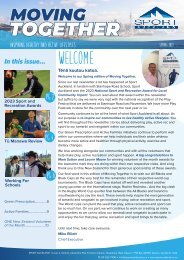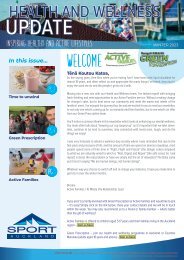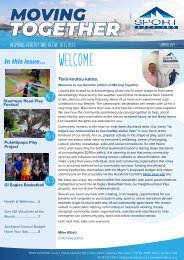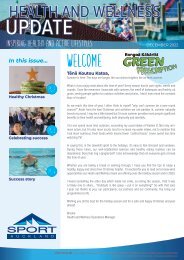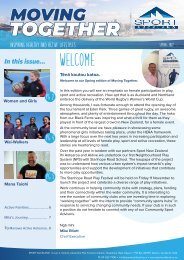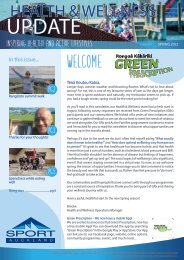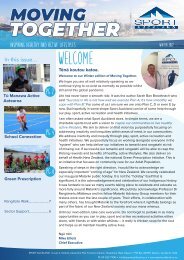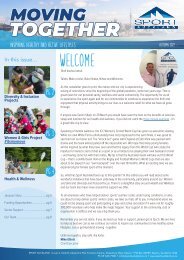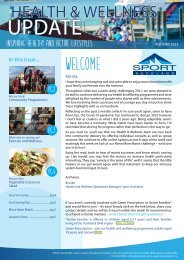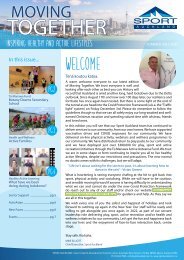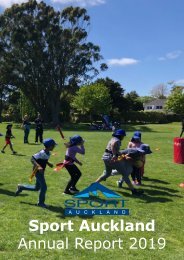2023 Annual Report
You also want an ePaper? Increase the reach of your titles
YUMPU automatically turns print PDFs into web optimized ePapers that Google loves.
Notes to the Financial Statements<br />
For the year ended 30 June <strong>2023</strong><br />
Notes to the Financial Statements<br />
For the year ended 30 June <strong>2023</strong><br />
(i) Financial assets at amortised cost<br />
Financial assets at amortised cost are non-derivative financial assets with fixed or determinable payments that are<br />
not quoted in an active market. Such assets are carried at amortised cost using effective interest method.<br />
Financial assets include cash and cash equivalents and accounts receivable.<br />
Cash and cash equivalents in the statement of financial position comprise cash at bank and in hand and short-term<br />
deposits with an original maturity of three months or less that are readily convertible to known amounts of cash and<br />
which are subject to an insignificant risk of changes in value.<br />
For the purposes of the statement of cash flows, cash and cash equivalents consist of cash and cash equivalents<br />
as defined above.<br />
Depreciation and amortisation is charged on a straight line basis over the useful life of the asset. Depreciation and<br />
amortisation is charged at rates calculated to allocate the cost or valuation of the asset less any estimated residual<br />
value over its remaining useful life:<br />
• Furniture and fittings 6.45% - 11.11%<br />
• Office equipment 10.00% - 40.00%<br />
• Office improvements 11.11% - 33.33%<br />
• Intangible assets 10.00% - 40.00%<br />
(ii) Financial liabilities at amortised cost<br />
Financial liabilities classified as at amortised cost are non-derivative financial liabilities that are not classified as<br />
fair value through surplus or deficit financial liabilities.<br />
Financial liabilities classified as amortised cost are subsequently measured at amortised cost using the effective<br />
interest method.<br />
Financial liabilities classified as amortised cost comprise trade, and other payables.<br />
(iii) Impairment of financial assets<br />
Short-term receivables are recorded at the amount due, less an allowance for expected credit losses (ECL). This<br />
allowance is calculated based on lifetime ECL. In measuring ECL, short-term receivables have been assessed on a<br />
collective basis where they possess shared credit risk characteristics. They have been trusted based on the days<br />
past due. Where a short-term receivable does not possess these similar characteristics, its ECL is individually<br />
assessed. Short-term receivables are written off when there is no reasonable expectation of recovery.<br />
Depreciation and amortisation methods, useful lives and residual values are reviewed at each reporting date and<br />
are adjusted if there is a change in the expected pattern of consumption of the future economic benefits or service<br />
potential embodied in the asset.<br />
4.6 Leases<br />
Payments on operating lease agreements, where the lessor retains substantially the risk and rewards of ownership<br />
of an asset, are recognised as an expense on a straight-line basis over the lease term.<br />
4.7 Employee benefits<br />
WAGES, SALARIES, ANNUAL LEAVE AND SICK LEAVE<br />
Liabilities for salaries and annual leave are recognised in surplus or deficit during the period in which the employee<br />
provided the related services. Liabilities for the associated benefits are measured at the amounts expected to be<br />
paid when the liabilities are settled.<br />
COMPARATIVES<br />
Where necessary, comparative information has been reclassified and repositioned for consistency with current year<br />
disclosures.<br />
4.5 Property, plant and equipment<br />
Items of property, plant and equipment are measured at cost less accumulated depreciation, amortisation and<br />
impairment losses. Cost includes expenditure that is directly attributable to the acquisition of the asset. Where<br />
an asset is acquired through a non-exchange transaction, its cost is measured at its fair value as at the date of<br />
acquisition.<br />
4.8 Income tax<br />
Due to its charitable status (Charities Services number CC23631), Sport Auckland is exempt from income tax.<br />
4.9 Goods and Services Tax (GST)<br />
Revenues and expenses are recognised net of the amount of GST except for receivables and payables, which are<br />
stated with the amount of GST included.<br />
The net amount of GST recoverable from, or payable to, the Inland Revenue Department is included as part of<br />
receivables or payables in the statement of financial position.<br />
4.10 Equity<br />
Equity is made up of the following components:<br />
Accumulated Comprehensive Revenue and Expense since Sport Auckland’s formation.<br />
50 <strong>Annual</strong> report<br />
<strong>Annual</strong> report<br />
51



